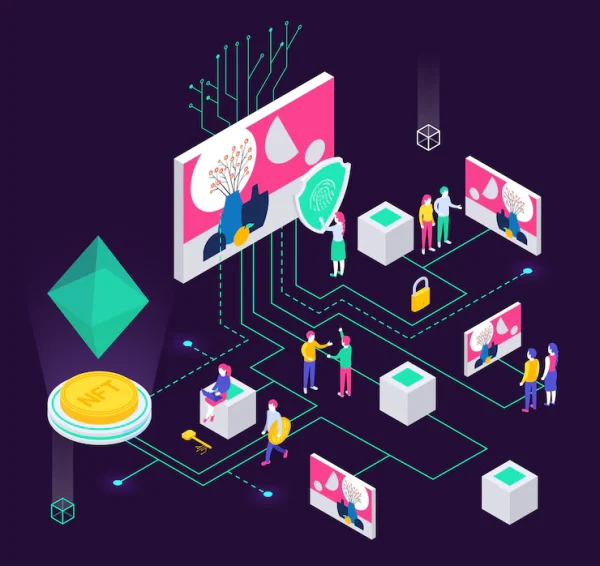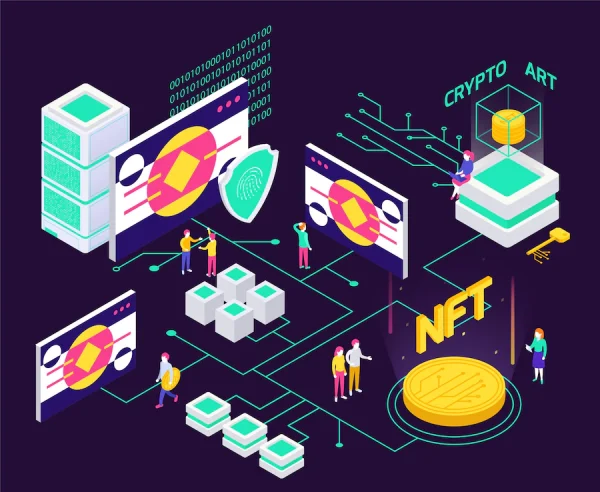Non-fungible Tokens, or NFTs, have emerged as one of the year’s innovations. NFTs have recently made news across numerous media. Many inventors, artists, and even business titans are eager to capitalize on this trend. Minting is an important stage in the creation of an NFT. In this essay, we will discuss what does minting NFT mean, how NFT minting works, and the associated expenses.
1. What Does Minting NFT Mean?
Watch the video to understand more about what does minting NFT mean ?
The process of converting digital data into crypto collections or digital assets stored on the blockchain is known as NFT mining. An NFT is a blockchain-based token that demonstrates ownership of a digital asset such as photos, video files, or even real items. Minting an NFT is the process of transforming digital data into crypto collections or digital assets kept on the blockchain.The digital products or files will be stored in a decentralized database or distributed ledger and will be impossible to edit, modify, or erase. When a manufacturer mints a physical coin, the process of uploading a specific item to the blockchain is referred to as minting.
The producers of the NFTs can schedule royalties from each subsequent sale throughout the printing process, which will become a commission they can collect each time their work is sold to someone else or exchanged on the secondary market.
2. How Much Time Does It Take To Mint An NFT?
It’s impossible to say how long it will take to produce NFTs.It’s difficult to predict how long it will take to mint NFTs. Almost all NFT platforms, tools, and markets, on the other hand, make the NFT creation process simple. Installing Metamask, an Ethereum wallet, as a browser chrome extension is the normal step for creating an account or authenticating into the major NFT marketplaces. This can be considered as the first stage where you can mint NFTs.
Converting your digital material to NFT, presenting it to NFT marketplaces, and advertising it for sale is analogous to uploading a video to YouTube, a music file to Spotify, or even selling a digital item or product for sale on Amazon, eBay, or Etsy. So, upload the file (PNG, JPG, GIF, MP3, or MP4), name it, add a description, set up royalties, and sell it.
3. Is it expensive to mint an NFT?
Yes. The Ethereum blockchain’s smart contracts are used to store and host the majority of NFTs and NFT marketplaces. The cost of using the Ethereum blockchain (generating NFTs, purchasing, selling, or transferring an asset at an Ethereum address) is known as the ‘gas charge’ or ‘Gwei.’ Depending on the demand for the Ethereum network or the NFT platform, this charge often ranges between $50 and $200.
4. Is minting NFT free?
Of course it is! One of the preferred methods of free minting NFT is lazy minting. ‘Lazy Minting’ is a common form of free NFT minting. Lazy minting is a method of minting in which NFT makers are not forced to pay for gas expenses. Fees will be collected when the NFTs have been acquired and transferred.
5. What to consider before minting an NFT?

Although minting NFT is simple on paper, there are a few things to consider before getting started. Minting NFT is the process of converting digital art into a public record on the blockchain platform. This is due to the fact that digital art would be impervious to alteration and manipulation. Minting refers to the process of adding NFTs to a blockchain in the same way that minting money refers to the process of creating currencies.
Make certain that your digital artwork is properly displayed. NFT ensures that the artwork may be acquired or exchanged on the market in a variety of ways. It allows for ownership tracking as well as possible resale or collection flexibility. Finally, a fundamental understanding of NFTs can provide a reasonable sense of how to approach their development and representation.
1. The Blockchain Platform
The first answer to the question ‘how to mint an NFT?’ is that there are numerous blockchains that support the NFT token standard. Some of the more dependable solutions are as follows:
- Ethereum : Ethereum is a decentralized, open-source blockchain that supports smart contracts. Ether is the platform’s native cryptocurrency. In terms of market capitalisation, Ether is second only to Bitcoin.
- Polkadot : Polkadot is a cryptocurrency and open source blockchain platform. It connects and interoperates blockchains by allowing separate chains to securely exchange messages and complete transactions with one another without the need for a trusted third party.
- TRON : TRON is a decentralized, open-source blockchain-based operating system featuring smart contract features, a proof-of-stake consensus process, and its own cryptocurrency, Tronix.
- EOS.IO : EOS.IO is a blockchain technology that is based on the EOS cryptocurrency. The platform for smart contracts claims to remove transaction costs and to process millions of transactions per second.
- Tezos : Tezos is an open-source blockchain that can perform peer-to-peer transactions and serves as a platform for smart contract deployment. The tez is the Tezos blockchain’s native coin. Proof-of-stake is used to gain consensus on the Tezos network.
2. The NFT’s Ecosystem
The understanding of NFT features in the blockchain you select is the next critical factor to consider when looking for the most cost-effective way to mint NFT. It is critical to ensure that the platform you use can handle NFT transfers and sales across several blockchains. With each blockchain, developers should weigh the advantages and disadvantages of the NFT ecosystem.
3. A Low-Cost Platform
Many ardent minters would attempt to create NFTs for the first time. As a result, people may be seeking a means to obtain an NFT for free. Popular options can be useful in these cases. The most popular blockchain systems for minting NFTs are currently Binance Smart Chain and Ethereum. Because of their huge scale, these two platforms may function as the largest NFT marketplaces while simultaneously giving extra insight to buyers.
4. The NFT Market
Finally, choosing an NFT marketplace is the most important aspect before NFT minting. In the case of the Ethereum blockchain, developers may encounter a significant number of NFT platforms. Some well-known examples are Rarible, Mintable, and OpenSea. Furthermore, Juggerworld, Treasureland, and BakerySwap are Binance Smart Chain markets.
6. How to mint an NFT?
Video: How to Mint NFT for beginners
Any digital information or file can be converted into an NFT art or asset. As a result, whether you are a content producer, graphic designer, or digital artist, you can quickly transform your work, whether it is 3D models, text files (documents, PDFs, or tweets), films, or music, into a collectable crypto asset with actual financial value.
In general, the procedure is straightforward; if you use Google Chrome, you can quickly install the browser extension ‘Metamask,’ which is the default wallet of most NFT markets and blockchain apps. However, make sure your wallet has Ether (ETH), the Ethereum blockchain’s native coin. You are now ready to develop your first NFT.
Most major markets and NFT platforms use the following as their default:
Connect your wallet to the NFT exchange.
When you connect your Metamask wallet, your profile on any Ethereum-based NFT marketplace (OpenSea NFT, Rarible, Nifty Gateway, Foundation, or SuperRare) will be activated, and from there you can create a username or display name, add a profile photo or cover photo of your collection, and add links to your social networks, personal blog, e-shop, or portfolio page.
Upload your file.
The process of uploading your file or creating your own NFTs is very simple; simply look for the ‘Create an NFT’ page in your preferred marketplace, and from there you can upload images in PNG, JPG, or GIF formats, music files in MP3 or.Wav formats, video files in MP4 format, or 3D files in GLB format. Remember that an NFT is a representation of a digital file or digital material, not the file or content itself.
Using centralized databases, such as cloud hosting services, might jeopardize your file’s security. Using temporary cloud storage services such as Google Drive or any other centralized database may not be the best long-term file storage solution for digital things converted into NFTs.
Mint your NFT.
Following the upload of your file or digital artwork, you may create or provide a title and a description to the item, and then click the ‘Mint NFT’ or ‘Is for sale’ button, depending on the platform.
Approve transaction fee.
All transactions on the Ethereum network incur a fee, which is paid with the Ether (ETH) coin. As a result, a gas cost or transaction fee will need to be allowed in your digital wallet at this point in order to complete the minting of the NFT.
Wait until your NFT has been coined.
The NFT minting procedure begins immediately when you submit the file and pay the gas price. The Ethereum smart contract executes code that will be incorporated in your artwork on the Ethereum blockchain during this process.
7. Popular NFT marketplaces for buying and selling NFTs

OpenSea NFT
The OpenSea NFT ecosystem is now the biggest. NFTs from the ERC-721 and ERC-1155 standards include art, virtual worlds, sports, metaverses, trading cards, and ENS domain names. Metamask is the default wallet for OpenSea, and it allows you to effortlessly purchase, sell, and trade NFT assets such as Decentraland, Axies (Axie Infinity), CryptoKitties, and others.
You may also simply develop your own NFT with the OpenSea platform’s digital asset creation tool, such as adding a new free item to your NFT collection. You may also sell your products by establishing a predetermined price, making an initial sale, or holding an auction.
Main categories: digital art, trading cards, sports, metaverses, collectibles, crypto collectibles, music, photography, games, etc.
Rarible
Rarible is an NFT marketplace that focuses solely on one-of-a-kind digital goods. This platform allows you to ‘mine’ fresh NFTs and sell your digital products, such as music, digital art, virtual environments, or movies.
Rarible allows you to buy and sell NFTs in a variety of categories, including art, photography, games, metaverses, music, domains, memes, and more.
Main categories: art, music, photography, DeFi, virtual worlds, Punks
Foundation
Foundation is a platform focused on digital art’s new creative economy. The platform allows you to earn up to 10% when someone resells your digital artwork.
Main categories: digital artworks
KnownOrigin
KnownOrigin is a marketplace for digital artwork powered by Ethereum. Files are stored on IPFS (Interplanetary File System) after you upload them in JPG or GIF formats.
Main categories: digital art
8. Conclusion
Some digital producers may make a fast profit by minting NFTs. However, keep in mind that this movement is still in its early stages. The online creative economy was a pioneer in the use of NFTs. The capacity to subserviently monetize material long after the actual sale may be a game changer for artists, musicians, content providers, video game makers, and others.
However, minting and selling NFTs should not be a get-rich-quick scheme. This method will necessitate some upfront expenses in order to sell your digital assets, and there is no guarantee that anybody will wish to purchase your work.


